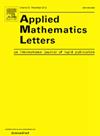具有非光滑初始数据的强迫Navier-Stokes方程的SAV-BDF2时间步进格式的无条件长[公式略]稳定性
IF 2.8
2区 数学
Q1 MATHEMATICS, APPLIED
引用次数: 0
摘要
本文研究了在初始数据u0∈H的正则化条件下,强迫Navier-Stokes方程的SAV-BDF2时间步进格式在保留对L2范数控制的同时将解提升到空间H1的长时间L2稳定性。在本文中,利用Shiue(2025)中引入的g-范数的改进估计以及Han和Wang(2024)的最新结果,建立了该方案的无条件长期L2稳定性。此外,解的能量范数的均匀时间界与时间步长无关,这允许更大的时间步长来加速模拟,特别是对于长期问题。这也改进了Han和Wang(2024)的结果,他们在涉及时间步长的条件下,假设初始数据直接在H1中,得到了能量范数的时间均匀界。本文章由计算机程序翻译,如有差异,请以英文原文为准。
On the unconditional long-time L2 stability of the SAV-BDF2 time-stepping schemes for the forced Navier–Stokes equations with nonsmooth initial data
In this work, the long-time stability of the SAV-BDF2 time-stepping scheme for the forced Navier–Stokes equations under a regularization of the initial data using a method that lifts the solution to the space while preserving control over the norm is investigated. In this paper, the unconditional long-time stability of the scheme is established by utilizing a refined estimate of the -norm introduced in Shiue (2025), together with recent results from Han and Wang (2024). Moreover, the uniform-in-time bound on the energy norm of the solution is derived independent on the time step size, which allows for larger time steps to speed up simulations, especially for long-term problem. This also improves the result in Han and Wang (2024) where a uniform-in-time bound on the energy norm was obtained under a condition involving the time step size and assuming the initial data is in directly.
求助全文
通过发布文献求助,成功后即可免费获取论文全文。
去求助
来源期刊

Applied Mathematics Letters
数学-应用数学
CiteScore
7.70
自引率
5.40%
发文量
347
审稿时长
10 days
期刊介绍:
The purpose of Applied Mathematics Letters is to provide a means of rapid publication for important but brief applied mathematical papers. The brief descriptions of any work involving a novel application or utilization of mathematics, or a development in the methodology of applied mathematics is a potential contribution for this journal. This journal''s focus is on applied mathematics topics based on differential equations and linear algebra. Priority will be given to submissions that are likely to appeal to a wide audience.
 求助内容:
求助内容: 应助结果提醒方式:
应助结果提醒方式:


